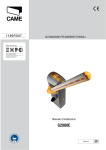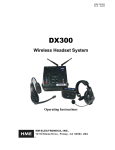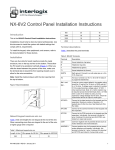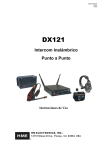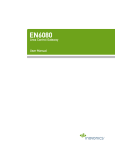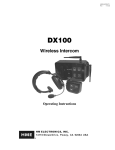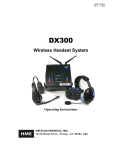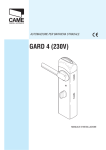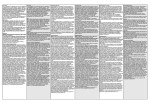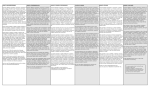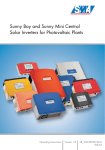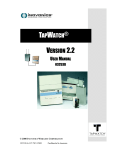Download S4787_Install Manual
Transcript
EN5040/EN5040-T/EN5040-20T High Power Repeater with Transformer 1.4 High Power Repeater Internal Components A B Installation and Operation Manual C 1 Overview The Inovonics high power repeater receives, decodes and retransmits signals at enhanced power from Inovonics devices. It acts as a range expander for any valid Inovonics transmission, including signals from other high power repeaters. High power repeaters can be layered as necessary, allowing Inovonics systems to scale from small commercial sites to complete campuses consisting of several buildings. The high power repeater features AC power loss and jam detection, as well as case tamper and wall tamper detection. Input power is provided by listed class 2 transformer, Good Power Electronics, Ltd. T48141428V010G or T48141428V020G, MPI-NEO Co., Ltd. W48A-K1429-2T. J 1.1 Maximum Number of Repeaters for a UL 2560 Installation To achieve the 99.99% alarm message reliability required for UL 2560 compliance, system installations must operate within the following limits for end device and repeater counts. End Devices Maximum Repeaters 150 397 250 386 350 375 500 360 1000 313 2000 238 3000 184 C C Power D Tamper input G Battery connector H Tamper mounting hole J Messaging mode selection pins One 14VAC/120VAC-20VA power transformer Three drywall anchors Three mounting screws One frequency band selection jumper 2 Installation and Startup Figure 1 High power repeater front panel B Transmit LED A A Housing release B Tamper button tabs spring E Reset button F Backup battery • • • • 1.3 High Power Repeater Front Panel D A Figure 2 High power repeater internal components 1.5 What’s in the Carton If you have any problems with this procedure, contact Inovonics technical services: • E-mail: [email protected] • Phone: (800) 782-2709; (303) 939-9336 B F I E I Frequency selection pins 1.2 Inovonics Contact Information A H D Note: For UL 2560 installations, refer to the EN6080 Area Control Gateway User Manual; for other UL installations, refer to the EN4216MR Installation and Operation Manual, the EN4232MR Installation and Operation Manual, or the EN7285 Installation Instructions. A Decode LED D Power LED G C Low Battery Fault LED Operation LEDs Decode LED: Flashes when any recognizable RF transmission is received. Transmit LED Lit when transmitting an RF transmission. Low Battery Fault LED: Lit when the high power repeater has a low battery. Power LED: Lit when receiving power. The LED lights green when the unit is receiving line power; red when receiving battery power. Note: If mapped to an output, the high power repeater will send the AC loss message to the EN6080 area control gateway when receiving power from the backup battery. 1.23.14 05066N © Inovonics, 2014 - www.inovonics.com 2.1 Installation Notes • These products are designed to be maintained by professional security technicians • Products are tested for indoor use • All products should be manually tested weekly 2.2 Select the Frequency Band EchoStream devices are able to use a range of radio frequencies, and must be configured for your geographic area. This device ships with a default frequency range of 902-928 MHz for use in North America. If you are using the device in North America, skip to 2.3, “Choose Messaging Mode”; if you are using the device in Australia or New Zealand, you will need to configure it. 1. Use a small screwdriver to press the top housing release tab and separate the housing (Figure 2). 2. Place a selection jumper on the frequency band selection pins appropriate to your geographic area (Figure 2). • Place the jumper on the left two pins, marked AU, to set the frequency range to 915-928 MHz for Australia. • Place the jumper on the right two pins, marked NZ, to set the frequency range to 921-928 MHz for New Zealand. Note: Only devices set for use in North America are configured for UL installations. 2.3 Choose Messaging Mode The EchoStream commercial mesh network includes two kind of messaging: broadcast messaging and directed messaging. The high power repeater includes a messaging selection option to protect the integrity of your system. The high power repeater ships with a default setting of broadcast messaging. If you are installing the device in a broadcast messaging network, skip to section 2.6, “Register the High Power Repeater”; if you are installing the high power repeater in a directed messaging network, you will need to configure it. 3. To set the high power repeater to directed messaging, remove the selection jumper installed on the messaging mode selection pins. Caution: Mount the high power repeater in a location removed from metal. Metal objects (duct work, wire mesh screens, boxes) will reduce RF range. 2.4 Connect Power Cabling Power must be connected to the high power repeater. To connect power to the high power repeater: 4. Use a small screwdriver to press the housing release tab on the top or bottom of the high power repeater (Figure 2); separate the housing. 5. Connect power cabling (Figure 2). • Wire should be two-conductor 20AWG (or larger) stranded-tinned copper with PVC insulation rated to 300 volts at 26°C (80°F). Wire length should not exceed 100 meters (328 feet). Note: For all UL installations, cabling must be UL Listed or Recognized, Class 2 wire suitable for the application. Use two-conductor 20 AWG (or larger) stranded-tinned copper, rated 300 volts, 60°C minimum. Wire length should not exceed 100 meters. • See section 1, “Overview” on page 1 for approved Class 2 transformers. • Route the cable from the transformer to the unit through the left side of the repeater, or through the oval knock-out section in the rear. • Torque screw terminal to 0.25 N-m (2.18 lb-in). Note: Do not secure transformer for Canadian installations. 2.5 Connect Battery Power The high power repeater is shipped with a fully-charged backup battery. You will need to connect the battery: 6. Plug the connector cable from the backup battery into the battery connector (Figure 2). 2.6 Register the High Power Repeater Although the high power repeater is functional upon startup, Inovonics strongly recommends you register it using the EN6080 area control gateway. Inovonics recommends all high power repeaters be supervised. When supervised, the EN5040 and EN5040-T will send a check-in message to the receiver every three minutes; the EN5040-20T will send a check-in message every 20 minutes. Note: In UL 2560 installations, the repeater sends a check-in message every 20 minutes. Note: Registration and supervision is required for UL installations. Note: In UL 2560 installations, refer to the EN6080 Area Control Gateway User Manual for registration information; in other UL installations, refer to the EN4216MR Installation and Operation Manual, the EN4232MR Installation and Operation Manual, or the EN7285 Installation Instructions. Caution: The reset bit will not be sent when the high power repeater has a low battery. Before registering the high power repeater, ensure the battery is fully charged. 2.7 Mount the High Power Repeater For best results, you will want to mount the high power repeater vertically, so that the antennae are oriented as shown in Figure 3. Antenna Antenna Caution: In UL 2560 installations, the unit must be mounted with the cable opening facing downward as shown in Figure 3. 7. Use the provided anchors and screws to mount the high power repeater in a location accessible for future maintenance. • In large installations, high power repeaters should be mounted so that every transmitter has multiple transmission paths to the EN6080 area control gateway. This kind of redundancy preserves system integrity in the event of temporary interruptions of any transmission path in the system. • For maximum efficiency, high power repeaters should be mounted with as few obstacles as possible between them and the EN6080 area control gateway. • Always perform a walk test after mounting, activating each transmitter assigned to the high power repeater and ensuring an appropriate response. 2.8 Enable the Wall Tamper The wall tamper must be enabled. If the high power repeater is removed from the wall, the cutout on the back of the housing will detach, activating a tamper alarm. To enable the wall tamper. 8. Attach one of the mounting screws to the wall through the tamper mounting hole (Figure 2). 2.9 Close the Housing The housing must be closed and the tamper spring in place to ensure the security of your system. 9. Check that the tamper spring is in place and makes contact with the high power repeater housing. 10. Close the housing. 3 US Patent Numbers • • • • 7,154,866 7,554,932 7,746,804 Other patents pending 4 Specifications Housing: 6.5" x 3.5" x 1" (165 mm x 89 mm x 25 mm) Weight: 7.14 oz (204 g) Operating environment: All UL installations: 32 to 140°F (0 to 60°C), 90% relative humidity, non-condensing; all other installations: -4 to 140°F (-20 to 60°C), 90% relative humidity, non-condensing Power requirement: 14 VAC, 60 Hz, 250 mA Battery capacity: 3.6 VDC nominal, 2900 mAh Typical back-up battery life: 24 hours Operating frequency: 915-928 MHz (Australia), 921-928 MHz (New Zealand), 902-928 MHz (USA) Battery charger operating environment: 32 to 140°F (0 to 60°C), 90% relative humidity, noncondensing Accessories: ACC650: weatherproof plastic enclosure for outdoor installations; BAT850: replacement lithium-ion battery assembly UL certifications for EN5040-T: UL 365, UL 636, UL 1023, ULC/ORDC1023-74, UL 1076, UL 1610 UL certifications for EN5040-20T: UL 2560 (see conditions below) Note: For UL 2560 installations, Inovonics repeaters must have 20 minute check-in times. Inovonics transmitters must have a minimum of 60 minute check-in times. Note: For UL 2560 installations, the EN5040-20T high power repeater may be used with completed emergency call systems for assisted living and independent living facilities For UL 2560 certified system installations, the following Inovonics EchoStream devices are approved for installation within maximum system configuration limits defined in section 1.1 of this document: • EN6080 area control gateway • EN5040-20T high power repeater • End devices (transmitters) with a minimum 60-minute check-in interval, as follows: Figure 3 High power repeater antenna orientation 1.23.14 05066N © Inovonics, 2014 - www.inovonics.com 2 - Fundamental devices which are subject to UL2560 certification (pendant transmitters and OEM products using the Inovonics RF module) - Supplemental devices which are not subject to UL2560 system certification but which may be used within a UL2560 certified system (e.g. universal transmitters and activity sensors) This warranty will apply only to Inovonics Products. Inovonics will not be liable for any direct, incidental, or consequential damage or loss whatsoever, caused by the malfunction of Product due to products, accessories, or attachments of other manufacturers, including batteries, used in conjunction with Inovonics Products. Note: E-mail [email protected] for a copy of the CE Declaration of Conformity. Note: Users that have achieved certification and will install UL 2560 certified systems are responsible for labeling all fundamental devices with the UL 2560 system certification mark. Compatible receiver for UL 2560 installations: EN6080 area control gateway Compatible receiver for all other UL installations: EN4216MR, EN4232MR, EN7285 US patent number 7,746,804 5 Television and Radio Interference This equipment has been tested and found to comply with the limits for a Class B digital device, pursuant to Part 15 of the FCC Rules. These limits are designed to provide reasonable protection against harmful interference in a residential installation. This equipment generates, uses and can radiate radio frequency energy and, if not installed and used in accordance with the instructions, may cause harmful interference to radio communications. However, there is no guarantee that interference will not occur in a particular installation. If this equipment does cause harmful interference to radio or television reception, which can be determined by turning the equipment off and on, the user is encouraged to try to correct the interference by one or more of the following measures: • Reorient or relocate the receiving antenna. • Increase the separation between the equipment and receiver. • Connect the equipment into an outlet on a circuit different from that to which the receiver is connected. • Consult the dealer or an experienced radio/TV technician for help. 6 FCC Part 15 and Industry Canada Compliance This device complies with part 15 of the FCC Rules and Industry Canada license-exempt RSS standard(s). Operation is subject to the following two conditions: (1) this device may not cause interference, and (2) this device must accept any interference, including interference that may cause undesired operation of the device. Le présent appareil est conforme aux CNR d'Industrie Canada applicables aux appareils radio exempts de licence. L'exploitation est autorisée aux deux conditions suivantes : (1) l'appareil ne doit pas produire de brouillage, et (2) l'utilisateur de l'appareil doit accepter tout brouillage radioélectrique subi, même si le brouillage est susceptible d'en compromettre le fonctionnement. 7 Warranty/Disclaimer Caution: Changes or modifications not expressly approved by the party responsible for compliance could void the user's authority to operate the equipment. Inovonics Wireless Corporation ("Inovonics") warrants its products ("Product" or "Products") to conform to its own specifications and to be free of defects in materials and workmanship under normal use for a period of thirty-six (36) months from the date of manufacture. Within the warranty period, Inovonics will repair or replace, at its option, all or any part of the warranted Product. Inovonics will not be responsible for dismantling and/or reinstallation charges. To exercise the warranty, the User ("User", "Installer" or "Consumer") must work directly through their authorized distributor who will be given a Return Material Authorization ("RMA") number by Inovonics. Details of shipment will be arranged directly through the authorized distributor. This warranty is void in cases of improper installation, misuse, failure to follow installation and operating instructions, alteration, accident or tampering, and repair by anyone other than Inovonics. This warranty is exclusive and expressly in lieu of all other warranties, obligations or liabilities, whether written, oral, express, or implied. There is no warranty by Inovonics that Inovonics product will be merchantable or fit for any particular purpose, nor is there any other warranty, expressed or implied, except as such is expressly set forth herein. In no event shall Inovonics be liable for an incidental, consequential, indirect, special, or exemplary damages, including but not limited to loss of profit, revenue, or contract, loss of use, cost of down time, or interruption of business, nor any claim made by distributor's customers or any other person or entity. This warranty will not be modified or extended. Inovonics does not authorize any person to act on its behalf to modify or extend this warranty. 1.23.14 05066N © Inovonics, 2014 - www.inovonics.com 3




